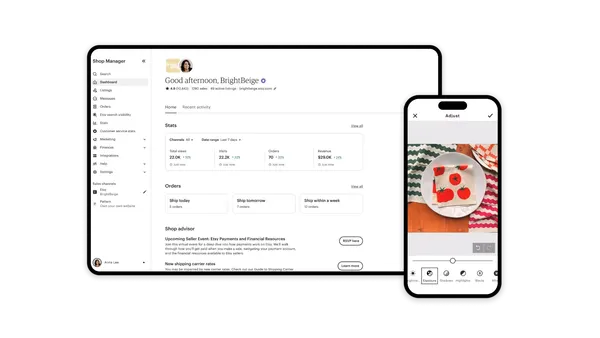There’s a noticeable gap among retailers between understanding the importance of omnichannel and having an actual strategy for improvement that works. It’s one thing to recognize the possible impact of a new strategy on your organization, but it’s another to build processes and implement flexible systems that quickly grow a company.
In a recent survey of 150+ retail organizations conducted by Deposco and Retail Dive, leaders were asked about their omnichannel fulfillment status and priorities. When questioned about the importance of omnichannel fulfillment, 87 percent of retailers say they know it’s important — but 64 percent aren’t satisfied with their omnichannel fulfillment performance. Many are either still seeking improvement, aren’t quite sure how their own omnichannel fulfillment strategies are performing, or aren’t sure where to start or what to improve.
Are legacy systems holding back your omnichannel progression?
The data shows retailers are facing several barriers to omnichannel fulfillment, including existing technology. In our survey, at least 12 percent of retail leaders said they’ve over-invested in enterprise resource planning (ERP) or legacy warehouse management platforms, leaving little to spend on more advanced omnichannel solutions.
Software technology systems are major financial commitments, so it’s understandable that some retailers are hesitant to let them go. But clinging to outdated or manual processes and systems only limits a retailer’s capabilities and holds them hostage to stagnation. Without up-to-date technology, you can’t roll out new services, track inventory efficiently, or scale quickly to meet demand as it changes.
Additionally, legacy systems don’t always integrate well with other critical solutions, which results in a domino effect — one legacy system must rely on another legacy system to function. Outdated systems also become expensive and difficult to maintain, creating stress on in-house IT resources. If new-release cycles are no longer available, IT often spends time on manual patches, adaptations and other workarounds to maintain the software.
An ERP typically lacks the capacity to integrate all the different aspects of the retail business, such as multi-location stores, online shopping, pricing changes, discount offers and more. When thinking about new omnichannel tech upgrades, consider this: How well does your existing ERP bring retail, online, app and marketplace sales together in one platform that can serve as the operational backbone of your business?
Meanwhile, a WMS should be able to take your retail organization to a new level of growth through enterprise-grade inventory visibility, modern automation and strategic order fulfillment. Can the existing WMS handle duties like automated pick-pack-ship and inventory tracking/syncing? Can it perform advanced order management functions without ever leaving your WMS?
Relying on legacy ERP or WMS platforms prevents retailers from moving to the next level of performance in many other ways, too.
First, business growth can be stunted by higher operational costs and lower productivity levels due to entering duplicate data into multiple systems or tracking additional information in spreadsheets. Many legacy solutions are built on disparate systems that don’t talk to each other and rely on manual or paper-based tasks, leading to increased risks of error and oversights. This, in turn, leads to inevitable bottlenecks and slowdowns. Moreover, outdated systems can result in major disruptions when trying to implement new sales channels (through marketplaces like Shopify, Amazon, or selling directly to consumers, for example).
Because systems aren’t integrated, leaders struggle with business blind spots. They don’t have insight into staff performance or other key performance indicators like inventory turnover, stock-to-sales ratios, rate of return, or perfect order rates.
Retailers without access to this data can’t make educated decisions about inventory or create accurate demand forecasts. Omnichannel fulfillment often begins with inventory alignment between in-store and e-commerce platforms, so it’s critical that these systems connect and talk to one another. Failure to connect those systems leads to negative customer experiences caused by unreliable inventory data, long fulfillment times and more frustrating return experiences.
Assessing your current omnichannel tech
So how do you know if your systems are up to the task of supporting omnichannel fulfillment? First, assess the limitations of the technology. Take an objective look at capabilities and ask questions like:
- What would it take to move the organization to the next level of omnichannel growth?
- What kind of bottlenecks do these platforms create for omnichannel fulfillment? How easily can you overcome them?
- What unexpected IT resources are needed to bring these existing systems along with you in your omnichannel fulfillment journey?
- What types of customer experience problems does the organization struggle with due to manual processes or systems that don’t integrate with each other?
- How well could these systems handle a migration to a new sales platform?
If you discover that your existing systems can’t support your omnichannel fulfillment journey, then it’s time to look for modern solutions. “To do this, you have to find the right partner to come in, help you understand your business, identify specifically what works, and find the landscape or ecosystem of solutions to help resolve those issues,” said Justin Stone, senior vice president of customer success at Deposco.
How does your omnichannel fulfillment progress compare to other retailers? Can your systems support your journey? Download the full research report to explore the results of the retailer survey and gain practical advice on simplifying an omnichannel supply chain while also facilitating scalability, adaptability and profitability as those omnichannel sales grow.










